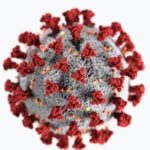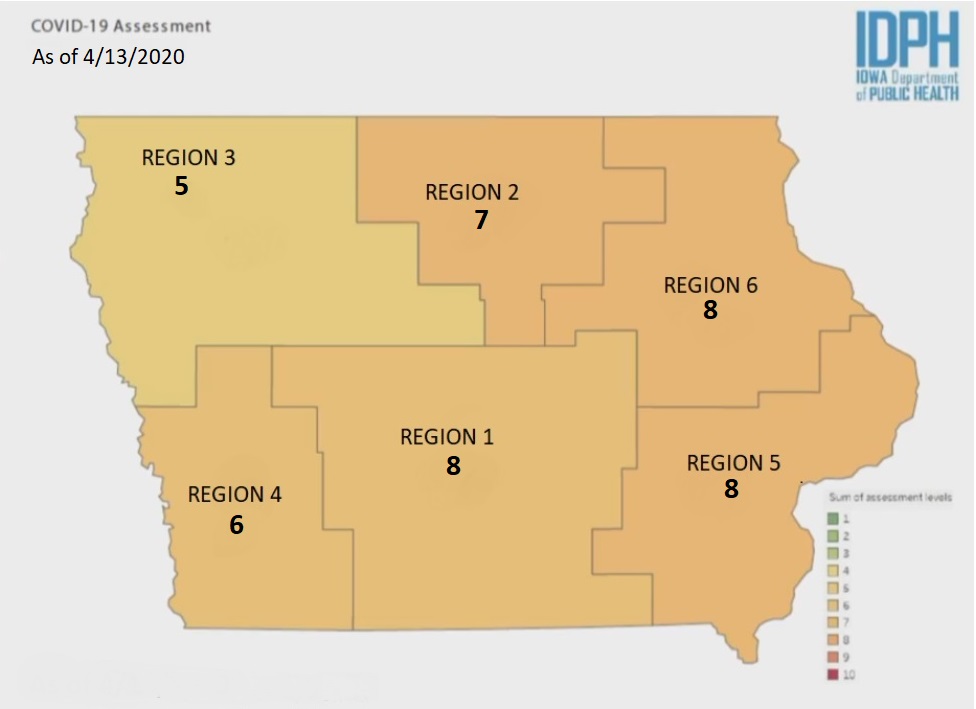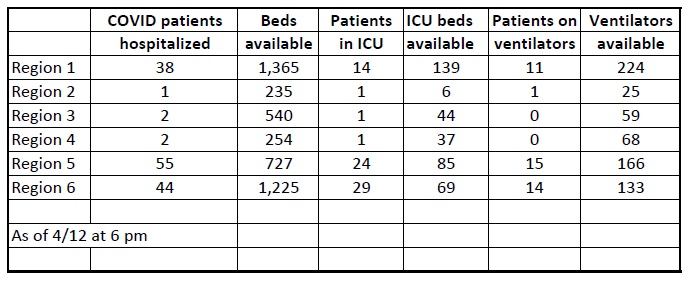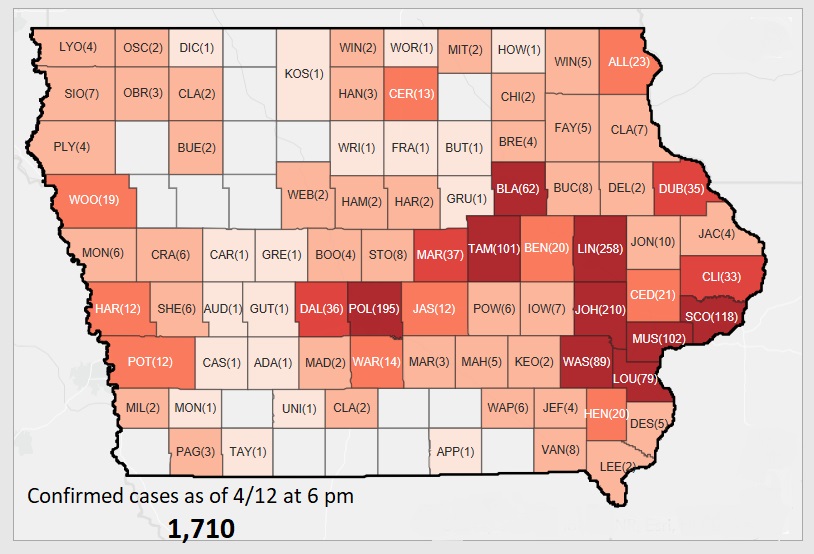 The Iowa Department of Public Health (IDPH) was notified of 123 additional positive cases of COVID-19 during the 24 hours ending April 12 at 6 pm, for a total of 1,710 positive cases. There have been an additional 981 negative tests for a total of 16,986 negative tests to date, which includes testing reported by the State Hygienic Lab and other labs.
The Iowa Department of Public Health (IDPH) was notified of 123 additional positive cases of COVID-19 during the 24 hours ending April 12 at 6 pm, for a total of 1,710 positive cases. There have been an additional 981 negative tests for a total of 16,986 negative tests to date, which includes testing reported by the State Hygienic Lab and other labs.
IDPH reports 741 Iowans have recovered from COVID-19. IDPH classifies a person as “recovered when it has been at least seven days since the onset of symptoms and the person has been fever-free for at least 72 hours.
Two additional deaths were also reported – a Linn County resident age 81 or older and a Muscatine County resident age 61-80. Forty-three Iowans have died of COVID-19.
In her daily press briefing Monday Gov Kim Reynolds called the number of persons who have recovered from COVID-19 “encouraging,” “but not reason enough to let up on our mitigation efforts at this time.”
She said the peak is still anticipated for late in April, “and until then, the number of positive cases, and unfortunately, the number of deaths, will continue to rise as well.”
Long term care facilities continue to be challenged. According to Reynolds, staff and residents of long term care facilities account for more than 10 percent of the COVID cases in the state; 53 percent of the persons who have died lived in long term care facilities.
IDPH is working to deploy Abbott rapid testing machines, which can provide a result in less than 15 minutes, to long term care facilities for “surveillance testing” among LTC residents and staff. Other testing methods take from two to as many as five days for results.
Using rapid testing, as soon as an essential worker has a positive test, persons she or he had contact with can be located, isolated and monitored for the illness.
Reynolds updated the metrics for the six Regional Medical Coordination Centers (RMCCs). A score of 10 would trigger a shelter-at-home order for the entire region or a portion of it.
Region 5, in which Iowa City is the hub for medical services, has decreased from a 9 last week to an 8. IDPH deputy director Sarah Reisetter explained that although the number of cases has increased, the severity of the illness in patients has decreased. The rate of hospitalization metric decreased from 3 to 2.
She also updated other numbers for each region.
Reynolds was asked what planning is being done for economic recovery once the pandemic has cleared the state. An Economic Recovery Task Force will begin with Iowa state department heads this week to identify the questions that need answers and what metrics will be used. The private sector will then be brought in.
Not all areas of the state will be “re-opened” at the same time, but Reynolds said, “It’s too early right now. We feel good about the direction we’re heading, but we’re still not at the peak…. We will get through this. We will recover. We want to open up the state as soon as we can, but we want to do it in a responsible manner. We don’t want to open it up just to have to shut things back down again.”
To another question, Reynolds reiterated that a decision about extending school closures past April 30 will be made by the end of the week.
According to IDPH, the locations and age ranges of the 123 newly diagnosed Iowans with COVID-19 include:
• Allamakee County, 2 adults (18-40 years)
• Benton County, 1 middle age adult (41-60 years), 2 older adult (61-80 years)
• Black Hawk County, 9 adults (18-40 years), 3 middle-age adults (41-60 years), 3 older adults (61-80 years)
• Bremer County, 1 older adult (61-80 years)
• Buchanan County, 1 middle age adult (41-60 years)
• Cass County, 1 middle age adult (41-60 years)
• Cedar County, 1 adult (18-40 years)
• Clinton County, 2 adults (18-40 years), 1 middle-age adult (41-60 years), 1 older adult (61-80 years)
• Des Moines County, 1 older adult (61-80 years)
• Fayette County, 1 older adult (61-80 years)
• Hardin County, 1 older adult (61-80 years)
• Henry County, 1 older adult (61-80 years)
• Jasper County, 1 middle-age adult (41-60 years),
• Johnson County, 3 adults (18-40 years), 3 middle-age adults (41-60 years), 1 older adult (61-80 years)
• Jones County, 2 middle-age adults (41-60 years),
• Lee County, 1 older adult (61-80 years)
• Linn County, 5 adults (18-40 years), 5 middle-age adults (41-60 years), 3 older adults (61-80 years), 2 elderly adults (81+)
• Louisa County, 1 adult (18-40 years), 1 middle-age adult (41-60 years), 1 older adult (61-80 years)
• Lyon County, 1 adult (18-40 years),
• Mahaska County, 1 middle-age adult (41-60 years),
• Marshall County, 1 adult (18-40 years), 4 middle-age adults (41-60 years), 1 older adult (61-80 years)
• Mills County, 1 middle-age adult (41-60 years)
• Muscatine County, 2 adults (18-40 years), 3 middle-age adults (41-60 years), 1 older adult (61-80 years)
• Polk County, 5 adults (18-40 years), 5 middle-age adults (41-60 years), 4 older adults (61-80 years), 1 elderly adult (81+)
• Scott County, 1 adult (18-40 years), 2 older adults (61-80 years)
• Story County, 1 adult (18-40 years)
• Tama County, 4 adults (18-40 years), 6 middle-age adults (41-60 years), 1 older adult (61-80 years), 4 elderly adults (81+)
• Van Buren County, 2 middle-age adults (41-60 years)
• Wapello County, 2 middle-age adults (41-60 years)
• Washington County, 1 adult (18-40 years), 5 middle-age adults (41-60 years), 2 older adults (61-80 years)
• Woodbury County, 1 middle-age adult (41-60 years)
